
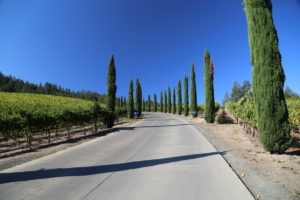
 Castello di Amorosa opened its doors to the public for the first time on Monday April 9, 2007 – this work of medieval architecture in the new world was conceived by long time Napa vintner Dario Sattui (also known as il padrone), owner of V. Sattui winery. Dario purchased this 171-acre property in March 1993 in what is now the Diamond Mountain District, one of 17 sub appellations within Napa Valley. This is an immense structure and down to the smallest detail, resembles a real medieval castle. Construction began in 1994 and lasted about 15 years with much of this time spent on the underground vaults and caves. We had the privilege of touring (translation: sneaking in) to the castle construction site several times before it was even open.
Castello di Amorosa opened its doors to the public for the first time on Monday April 9, 2007 – this work of medieval architecture in the new world was conceived by long time Napa vintner Dario Sattui (also known as il padrone), owner of V. Sattui winery. Dario purchased this 171-acre property in March 1993 in what is now the Diamond Mountain District, one of 17 sub appellations within Napa Valley. This is an immense structure and down to the smallest detail, resembles a real medieval castle. Construction began in 1994 and lasted about 15 years with much of this time spent on the underground vaults and caves. We had the privilege of touring (translation: sneaking in) to the castle construction site several times before it was even open.
Prior to Sattui’s purchase the property had a number of owners over the decades and some fascinating history. In the 1980s it was owned by Andre Bosc and his wife Mary (Scottie) who wanted to build a winery on site called St. Michael’s Winery. He even hired winemaker Tom Eddy, but plans never materialized for its construction. However by the time Sattui purchased the property it already had the coveted permits, granted in 1989 to build a winery (thanks to the efforts of Bosc). This was the last open-to-the public winery permit Napa County granted.
Its early history dates back to William Houston Nash who came to California in 1846, joining the Donner Party as far as Salt Lake City. He settled on this property in 1848 and called his land, Walnut Grove. Anyone westerner who was living in Napa Valley in the 1840s were among some of the valley’s earliest settlers. For reference, George Yount, the first western settler in Napa Valley planted the regions first wine grapes in 1838/1839 only 10 years prior to Nash’s settling here.
Napa Valley’s first school house was built on this property in 1847. Nash built a home in 1848 here, which remarkably is still standing. According to Dario, the house has been used as a small hotel and also served as a Wells Fargo Stage stop. The Nash house is among the three oldest still extant buildings in Napa County; the oldest is the Cayetano Juárez Adobe, dating to 1845 and currently home of the delicious cuisine from Le Chevre Bakery and Rancho Chiles Adobe dating back to the mid 1840s, currently a private residence in Chiles Valley on the Dollar Ranch.
Nash grew some of the earliest fruit trees in Napa Valley including peaches. He was appointed treasurer in 1856 of a group that ultimately built a Baptist Church in St. Helena in 1857. He also ran for Napa County Supervisor in 1872. According to an article in The Napa Register dated August 9, 1898, Nash visited his old property this year, for the first time since he left in 1866.
For a few years in the early 1870s he owned Magnolia Farm and nurseries in what is now the Oak Knoll District of Napa Valley. Magnolia Farm grew numerous fruits including cherries, prunes and apples, all of which were sold. Young fruit trees were also for sale. An article in The Napa Valley Register dated November 22, 1879 indicated Japanese persimmons were imported to the U.S. for the first time in 1876 and already Magnolia Farms had some fruiting trees, although by this time the farm was no longer owned by Nash. Later in the decade Nash lived in Santa Rosa in neighboring Sonoma County and was active in gold mining in Mariposa County in the foothills of the Sierra Nevada.
While living in San Francisco he was part of the firm, Eveleth & Nash, a wholesaler dealer in foreign and domestic fruits, nuts and produce. This company was founded in 1880 and as their business grew, incorporated in 1896 as Eveleth & Nash Company. For 22 years their office was located at 422 Front Street, now the site of a tall skyscraper. They moved into much larger digs, still on Front Street in October 1906, just about exactly 6 months after the earthquake and fire in in April 1906 destroyed their former building. The last reference we can find of this business was in 1931. Through his business dealings and visits to orchards around the state, he was well known in California by other fruit-growers. It is interesting to note that another of Napa Valley’s early settlers, John Lewelling (reference Lewelling Vineyards) was also a prominent horticulturist and orchardist.Nash died in 1900 and is buried in the old White Church Cemetery located in Bothe State Park not far from this property. In 1891 he had the remains of other family members moved from private land to this same cemetery. His obituary published in numerous newspapers around California mentioned he sold his first crop of peaches to a merchant in San Francisco for $1 each, an incredible sum of money for a piece of fruit in the mid 1800s.
—
Dario and his wife live in a beautiful and historic Queen Ann 10,000 square foot, 20 room mansion next to Highway 128. It is located just south or to the left as one drives into the main entrance before the driveway starts. Prudence Shamp moved here in 1874 while her husband Thomas remained in Virginia City, Nevada. He had been involved in mining activities in that town since the 1860s, at one point he was superintendent of the Ophir Mine, the site of the first discovery of precious metals in the Comstock Mining District and later the Savage Mine. His work with the mines was very profitable. Thomas passed away in this home in June of 1875; his obituary in the Yerrington Times mentioned he was, “one of the heaviest men in Nevada”.
Transportation in those days wasn’t easy; when Prudence moved to California from New York in 1858 with three small children, her ship grounded on corral reefs in Florida and was wrecked for two weeks before she and other passengers were able to leave the island and continue their journey.
An article in The St. Helena Star dated March 2, 1888 refers to another article in the Calistogan newspaper and mentions that Hugh and Thomas Shamp, Prudence and Thomas’s children, were in the process of pulling out 35 year old Mission vines on their property. Estimates of age like this are often off by a few years, especially in those days, but if taken literally, would have meant that these vines were planted on this property around 1853. The article also stated that 4 men were removing 350 vines a day and that they would be replanted to prunes (a more profitable crop than Mission grapes).
Prudence died in this home in 1897. After her death the property changed hands a number of times. In 1902 San Francisco glue manufacturer and real estate investor Martin Holje (a native of Germany) and his wife Elizabeth acquired the property and enlarged the home; Martin died in San Francisco in 1914. During his ownership he renamed the property to Maplewood(e) and would often use the property as a summer home (his other residence was in San Francisco). An article in the Calistogan from April 1909 mentions he was in the process of planting 1,600 Bartlett Pear trees and was growing alfalfa on part of his property.
In 1926, Elizabeth Holje sold the property to Berkeley based manufacturer Curtis Wright for $90,000. At the time the property was listed as being 400 acres and was still planted to the Bartlett trees and wine grapes. Wright leased the property for the agricultural products to the Kelly Brothers of Calistoga. Elizabeth’s obituary in the St. Helena Star in July 1938 mentions she donated the land for what is now the still standing Tucker Farm Center.

 Wright was an avid gardener; the Napa Journal dated April 10, 1931 describes his property as being, “one of the most attractive gardens in the valley”. He grew camellias and also built a prominent rock garden in front of the home with fountains, ponds and also a greenhouse. He was also the first president of the Napa Valley Co-op Winery (founded in 1934.
Wright was an avid gardener; the Napa Journal dated April 10, 1931 describes his property as being, “one of the most attractive gardens in the valley”. He grew camellias and also built a prominent rock garden in front of the home with fountains, ponds and also a greenhouse. He was also the first president of the Napa Valley Co-op Winery (founded in 1934.
In 1944 the Wrights sold the property to Charles Forni; Forni was on the original founding board of the Napa Valley Coo-op Winery in 1934 and a founding member of the Napa Valley Vintners in 1944. Incidentally Forni had worked on this property when he was 13 years old, employed by Martin Holje. After his purchase, Forni renamed the house to St. Michael’s Villa in homage to the name of his childhood home in Italy. The Forni family have contributed to Napa Valley over the years including Charles’ grandson, winemaker Michael Forni and until 2018 Calistoga located Forni-Brown-Welsh Gardens. Today Forni Farm & Nursery is located in neighboring Sonoma County operated by Charles’ great great grand daughters.
The Forni family owned the property until 1960 when they sold it to real estate developer Andre Bosc and his wife Mary. According to Bosc in an interview in the July 10, 1986 issue of The Napa Valley Register the property was zoned for 140 condominiums at the time of his purchase on the lower part of the property. Bosc grew up in Napa Valley; his father Albert Bosc was a rancher on Howell Mountain having moved there in 1919; he grew and sold wine grapes. In 1938 with Prohibition not far in the rear view mirror, state and federal agents found an illegal brandy still and winemaking operations on the Bosc property. He listed for sale ads in the 1930s in local newspapers for Carignan and Sangiovese that he was growing on his Howell Mountain property.
The mansion has been in scenes of the badly rated 1974 made for TV horror film, Killer Bees, and in the much better rated movie from 1960, Pollyanna and in the 1974 TV show, Streets of San Francisco, episode River of Fear with young actor at the time, Michael Douglas. After Dario purchased this property he renovated and renamed the old mansion to Villa Amorosa.
—
Castello di Amorosa’s long steep cypress lined driveway is located off of Highway 128/29 just south of the town of Calistoga; as your climb the driveway and crest the hill, one’s eyes feast on truly a spectacular site as this massive Tuscan style castle comes into view.
As expected with such a unique structure, “the castle” as it is colloquially called by locals in Napa Valley attracts sizable crowds. Guests interesting in visiting with the fewest amount of people should consider arriving on a winter weekday at 930am when they open (visits are by appointment).
Parking is in a large lot located near the main entrance. The first few parking spots are reserved for use by wine club members only. During busy weekends, cars are wrapped around the road leading in front of the winery and down the main road. Simply put, this is one of Napa’s most popular wineries and it can get extremely crowded. Of all the wineries we have visited in Napa Valley this one offers one the best chance of hearing languages from around the world as the castle sees a diversity of visitors from numerous countries.
Old, gnarled olive trees dating from the late 1800s were cut back, transplanted and grow in front of the castle. These trees help add to the appearance and feel of this being an ancient site. Unlike other trees, established olive trees generally survive a relocation and replanting.
The castle contains four levels of underground cellars, by numbers – 100+ rooms spread over 8 levels, 121,000 square feet or from another perspective, encompassing some 3 acres of rooms! Nearly 200 containers of shipping materials were transported from Europe and over 8,000 tons of locally quarried stone were used in the construction all chiseled by hand by 16 different stone masons. Nearly 1 million handmade bricks were shipped over from Italy. Dario shipped other pieces of the castle over from Italy as well as hired Italian craftsmen to hand paint exquisite colorful frescos and other murals.
The castle features escape tunnels, a central courtyard, turrets (great view by the way of the northern Napa Valley from the top of one of these), a small chapel, the Great Hall and some very interesting and historical wine making artifacts, some of which date back several hundred years to when they were originally used in Europe. The fireplace and mantle in the Great Hall are more than 500 years old (its date of construction clearly shows as 1447). Of these artifacts perhaps the most interesting is a wooden basket style press which dates from 1780 (located near the main courtyard on the ground floor). It is massive and we can only speculate on the shipping costs from Italy where it originated.
It is hard to imagine when you first pull into the parking lot, but this is a working winery. The production facility is located towards the back of the castle. The property is 171 acres of which 30 are planted to vine.
One of the main highlights of a visit is walking into the Great Hall. It is an impressive rectangular room beautifully decorated with hand painted Italian style frescoes; individual stories accompany each mural. These frescoes (including the art on the ceiling) was hand painted over 18 months by the Italian artist Fabio Sanzogni. The floor is made up of stone bricks from Luxembourg estimated to be around 400 years old – the massive wooden oak doors were imported from Italy.
 If you know where to look among all these frescoes that line the walls you will spot the Sattui family coat of arms on a shield. Above this is written “I am the lord of the vines and when you find me good, I make everybody happy and give peace of mind!”
If you know where to look among all these frescoes that line the walls you will spot the Sattui family coat of arms on a shield. Above this is written “I am the lord of the vines and when you find me good, I make everybody happy and give peace of mind!”
A long wooden dining table is located in the middle of this room; a table of this size certainly must be used and it is – members of their wine clubs enjoy some memorable parties. Jesters, jugglers, royal musicians, sword play, and jousting events accompany some of these events.
One of the largest events is the annual mid summers festival. Over the years, a number of celebrities and politicians have stopped by including Arnold Schwarzenegger. Disney filmed a movie here called Bedtime Stories, with Adam Sandler and other filming included a scene from The Bachelor, a Fiat Commercial and scenes for a video game. And in 2022 Disney premiered The Quest, fantasy-based reality television series in which Castello di Amorosa is prominently featured in some of the scenes. Continue to look for more Hollywood interest in the future. The castle is the perfect set!
In early autumn 2020, the Glass Fire burned through this part of Napa Valley including the Castello di Amorosa property. The roof and tower of the large Farmhouse caught fire (located behind and to the north of the castle). About 120,000 bottles of wine were stored here at the time including some of the 2020 vintage which was still fermenting. The total estimated loss was somewhere between 15 and 20 million USD. The roof was completely restored by the spring of 2023.
As of our latest update, Castello di Amorosa produces nearly 30 different wines from both Napa Valley as well as other California vineyard locations including as far away as Temecula in Southern California. The winery owns approximately 130 acres of vineyards in Napa Valley, Sonoma County and Anderson Valley in Mendocino County. In addition to vineyards under their ownership, Castello di Amorosa also purchases grapes from other growers. As of our latest update to this review, they source grapes from several highly regarded vineyards including Morisoli-Borges in Rutherford and Melanson on Pritchard Hill. Some of their single vineyard bottlings and other red wines regularly receive mid to high 90-point scores from prominent wine critics and wine magazines.
And over the years, both Castello di Amorosa and V Sattui have donated approximately 700 acres into several land trusts so that land will never be developed.
In 2023 all of Castello di Amorosa’s vineyards are now certified CCOF (organic). And their vineyards in Napa Valley are certified Napa Green. This certification program is managed by Napa County Department of Public Works and the California Green Business Program overseeing water conservation and reduced energy and waste within Napa based County wineries. Natural fertilizers are used among their vines, and sheep are allowed to graze at certain times of the year.
Dario donated 4.5 million USD to San Francisco based Gladstone Institutes, a bio medical research organization. The funds are being used to support scientists in their research of heart failure and heart fibrosis including creating a specific laboratory for such studies.
Those looking to read more about Dario’s journey in building Castello di Amorosa can read his hardcover book, Castello di Amorosa: A Labor of Love published in 2017. This book features plenty of photographs of the castle during construction and after it was completed. This is a must have for castle enthusiasts.
Guided Tours
Visitors enter the castle by crossing a wooden drawbridge (yes it does raise). After one passes through the giant wooden doors you will be directed to the Castaldo room on your left. Choose from a variety of tour and tasting options (limited areas of the castle are accessible with the self-guided tour). For a more in-depth experience including a visit to the dungeon choose the guided tour and tasting. This guided tour lasts about 2 hours including the tasting; there is no other tour in Napa Valley quite like this one.
During your tour notice the details that went into the construction. Attention to detail went into every facet of the construction; many of the stones were chiseled by hand as was all the iron work. Case in point is the one turret which appears to be damaged, probably from cannon ball fire. This was left this way to appear like the castle suffered an attack. If you see something built into the castle that you have a question about, the most common answer you will receive from your guide is “well that’s how it would have been 800 years ago.”

 During the tour you will forget you are in a fully functioning winery until you exit the rear of the castle and enter the tank room. Triple jacketed steel tanks are used to so tank temperatures can be carefully regulated during fermentation. These types of tanks were quite rare at the time of their installation – we have since seen other triple jacket tanks at select local wineries.
During the tour you will forget you are in a fully functioning winery until you exit the rear of the castle and enter the tank room. Triple jacketed steel tanks are used to so tank temperatures can be carefully regulated during fermentation. These types of tanks were quite rare at the time of their installation – we have since seen other triple jacket tanks at select local wineries.
A small “dungeon” room, (also called “The Pit of Despair or the Armory) contains some of man’s most medieval devices for torture including a rack which was originally used to stretch limbs – a truly agonizing method of torture. Look for several other nasty looking pieces of equipment including the highly confining “iron maiden” with its sharp interior spikes which dates from the late Renaissance period. Dario purchased this at an auction and of all the torture items contained here, this was the only one that was actually used – our guide told us the DNA of 146 different people were identified from ancient blood residue inside. Right, you will *not* see this type of stuff on any other Napa Valley winery tours.
Numerous narrow brick walkways and tiny rooms are located near the torture room, and it can be easy to get lost down here. Castello di Amorosa’s first vintage was in 2000, however Dario wasn’t pleased with the quality of his wines – so rather than release and sell this wine, he hoarded it. Today some 40,000 bottles are stacked up in some of the small rooms throughout part of the lower levels.
Towards the end of the tour, guests used to try wine directly from a barrel from the largest room in the castle (the primary barrel room) covered with brick arches and housing numerous oak barrels. Apparently, someone got a little crazy on one of the tours, testament to the broken glass scattered around the tasting area during our last visit.
Unlike most Napa Valley based wineries, Castello di Amorosa produces a number of dessert wines. The Reserve Tasting offers samples of some of their more limited production higher end wines.
Tours end with a tasting (either a general or reserve depending on which one you paid for). The tasting counter is in a small dimly lit brick room below the main courtyard – only those from your tour are lined up along the counter – this is a good chance to meet others from your group. Mark the wines you want to taste on the tasting card. Several small bread items and other pairings are available.
Keep in mind you are in the Castle of Love and romantic inclinations combined with glasses of wine are a true possibility here. If you see someone staring at you from across the tasting room, and they keep staring – give them a smile and walk over and introduce yourself.
A number of items for sale are organized around the tasting room including pasta imported from Italy and olive oil harvested and produced from their Morning Dew Ranch in Anderson Valley (Mendocino County).
Wondering why a number of employees in the tasting room speak Italian? Dario employs young interns (generally in their early to mid 20s) from Italy who speak good English, some of whom are housed in the ‘intern house’ on the other side of the valley. Some of these employees are from the Accademia Symposium in the Franciacorta region, south of Iseo Lake; they have two years of education on hospitality/wine tourism and are certified WSET Level 2.
Select wines
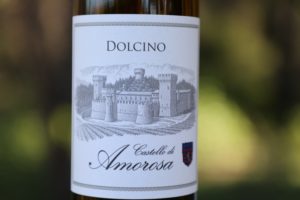

 White wines
White wines
The 2022 Castello di Amorosa Dolcino Anderson Valley Gewürztraminer is pale to medium yellow in color; if sunshine had a smell, one might imagine the aromas would be similar to what one smells on this bouquet. It is both floral and simultaneously tropical, with scents of star jasmine, citrus blossom, ripe lychee, papaya, pear, honey and pineapple. There is also a very subtle herbal quality which adds a light spice note to the bouquet, perhaps a smell of pine needle, fir branch or even ginger or maybe a combination of all three. The palate offers a noticeable (but not syrupy) sweetness which continues to persist on the fruit filled rich and long-lasting finish. It reveals flavors of apricot, pineapple, yellow peach, nectarine and very ripe pomelo. The accompanying texture is supple and smooth. This wine is named Dolcino because that word in Italian literally translates to “sweetie” or in the case of this bottling, a wine that is slightly sweet. It was aged in stainless steel tanks with a residual sugar of 35g/L.
Vermentino is commonly grown in Provence in the south of France where it is known as Rolle. There is very little of this variety planted in Napa Valley; we are aware of only four vineyard sites in Napa Valley including two on the Napa Valley side of Carneros (Mahoney) and Steve Matthiasson’s Cressida Vineyard and two in Rutherford including the Rutherford Dust owned by Neal Family and AJT Vineyard owned by the Terlato family (Rutherford Hill Winery). The very few Napa Valley producers that make wines from Vermentino usually source grapes from outside of the county, including to date, Castello di Amorosa. According to the 2022 California State Grape Acreage Report in 2021 there were 4 bearing acres of Vermentino growing in Napa Valley. There will be more planted.
The 2023 Castello di Amorosa California (Temecula) Vermentino offers a lively, fruit forward and playful bouquet. The heady and intense aromas showcase plenty of florals including honeysuckle, daffodil and citrus blossom accompanied by pear, lime, lemon-drop candy, honeydew melon and grapefruit. Simultaneously tangy, tart and sweet (from the grapes, not residual sugar), on the palate there are flavors of Gravenstein apple, limeade, underripe pineapple, apricot, grapefruit pith, pomelo and lemon juice. This variety is often associated with a light bitter character on the finish; we did not notice that in this wine. Its acidity is zippy, zesty, juicy and mouthwatering. The finish lingers bright as a high wattage halogen lamp and immediately begs another sip. We could see ourselves with this bottle, in the company of a beautiful lady, perched above one of northern California’s rugged coastline views with a plate of freshly harvested and shucked raw oysters and tangy mignonette sauce.
The 2023 Castello di Amorosa Pinot Bianco, Mendocino County is medium straw in color; the bouquet is a union of both floral and other fruits including star jasmine, honeysuckle and citrus blossom, accompanied by lively citrus scents of lemon juice, kaffir lime, tropical guava on the greener side of the ripeness spectrum, green apple and freshly cut lawn. Based on the bouquet, we were expecting more citrus influence on the palate, but this is not the case. It offers flavors of white nectarine, white peach, comise pear, red delicious apple, honeycomb, guava, apricot, lychee and mandarin orange. We possibly picked up a light amount of residual sugar, but its balanced out very nicely by its lively acidity. Or maybe this is just a honeyed undertone, inherent to this variety. Finishes refreshing with a zesty mouthwatering character. This wine drinks well by itself, but if we were to choose a pairing it perhaps would be with freshly caught cod or tilapia or more exotic, a Thai red curry with sweet chili green beans, chicken and kaffir lime leaves.
Red Wines
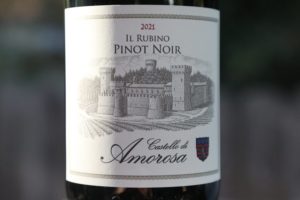
 The 2021 Castello di Amorosa Il Rubino (translates from Italian to English as, ‘the ruby’) Pinot Noir is pale ruby in color; she shy bouquet takes some time to evolve and open in the glass. It offers scents of raspberry, red plum, strawberry, dried tobacco, tea leaves, a hint of clove, mushroom, truffle oil and a light note of Tonka bean; look that aromatic up if you are not familiar with it. We weren’t until it was pointed out to us in a Burgundian Pinot Noir during a trip to Burgundy. Balanced and easy drinking, on the palate there are flavors of raspberry, red cherry, strawberries, dried cranberries and currant. Lively and brightly lit, this wine is showing in a nice place, three years post vintage at the time of our tasting. The tannins are noticeable, which we always appreciate in wines from this variety. Often the tannins are ‘rolled over’ from California wines of this variety – removing all of their inherent grip due to ripeness. That is not the case with this bottling; they sport a lightly grainy and drying grip which lingers on the bright and red fruited finish. We would love to pair this with a plate of Peking duck served at Morimoto’s Asia Restaurant in downtown Napa. North coast appellated, the grapes were sourced from vineyards in Anderson Valley, Mendocino Ridge, Sonoma Coast and the Green Valley in the Russian River Valley of Sonoma County. This wine was aged for 11 months in Burgundian French oak barrels of which 45% were new. 13.8% alcohol.
The 2021 Castello di Amorosa Il Rubino (translates from Italian to English as, ‘the ruby’) Pinot Noir is pale ruby in color; she shy bouquet takes some time to evolve and open in the glass. It offers scents of raspberry, red plum, strawberry, dried tobacco, tea leaves, a hint of clove, mushroom, truffle oil and a light note of Tonka bean; look that aromatic up if you are not familiar with it. We weren’t until it was pointed out to us in a Burgundian Pinot Noir during a trip to Burgundy. Balanced and easy drinking, on the palate there are flavors of raspberry, red cherry, strawberries, dried cranberries and currant. Lively and brightly lit, this wine is showing in a nice place, three years post vintage at the time of our tasting. The tannins are noticeable, which we always appreciate in wines from this variety. Often the tannins are ‘rolled over’ from California wines of this variety – removing all of their inherent grip due to ripeness. That is not the case with this bottling; they sport a lightly grainy and drying grip which lingers on the bright and red fruited finish. We would love to pair this with a plate of Peking duck served at Morimoto’s Asia Restaurant in downtown Napa. North coast appellated, the grapes were sourced from vineyards in Anderson Valley, Mendocino Ridge, Sonoma Coast and the Green Valley in the Russian River Valley of Sonoma County. This wine was aged for 11 months in Burgundian French oak barrels of which 45% were new. 13.8% alcohol.
The “Gioia”, a rosé of Sangiovese is quite popular with visitors and is one of their most affordable bottlings. Literally translated to “Joy” in English, there is no joy in the castle when they are sold out of this wine.
The 2019 Castello di Amorosa Sangiovese Napa Valley is 92% Cabernet Sauvignon and 8% Merlot. This wine is medium ruby in color; the Sangiovese grapes for this wine come from both the estate vineyard located at the castle and the Voyager Vineyard. The bouquet offers aromas of bittersweet chocolate, cloves, creosote bush, bramble, red plum, rhubarb, a dark woodsy spice and deeper into the aromatics, a note of dark pepper. As the wine evolves the fruit starts showing a bit more including of raspberries and cherries. It offers some spice notes on the palate, including of spicy plum skim and notes of toasted oak which especially continue to persist on the finish. Lingers savory with notes of crushed peppercorn, dried herbs, dried tobacco leaf, a dust nuance and light but grainy tannins. This wine was aged 18 months in Burgundian French oak of which 35% were new barrels.
The only non-blended wine we tried is the 100% Diamond Mountain grown “II Barone” Cabernet Sauvignon. This is a big wine with rather robust tannins on the finish. This is among their most premium bottlings and is often highly rated; a small cellar room within the bowels of the castle is even devoted to aging this particular wine. The Sinalunga Cabernet Sauvignon is their most premium bottling of this variety.
The 2014 Castello di Amorosa Cabernet Sauvignon was grown on site; the bouquet shows aromas of spice including white pepper, red fruits and a hint of sweet mocha as the wine opens further. Medium bodied shows more red fruit on the palate then darker fruit. Fairly well balanced – the tannins are slightly dusty, still a bit tightly woven and finish with earth notes, flavors of red cherry and a cedar spice nuance.
Dessert Wines


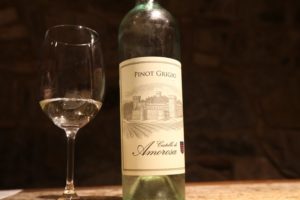 During various visits, we have also sampled their entire flight of dessert wines. Il Raggio del Sole translates from Italian to “ray of sunshine” in English. The 2023 Castello di Amorosa Il Raggio del Sole Santa Barbara County Moscato is pale yellow in color; fresh, fruity, sweet with a light herbal undertone, the bouquet is immediately inviting to consumers who enjoy dessert wines. It offers sweet and ripe fruited aromas of apricot, yellow peaches in light syrup, nectarines, lychee, star jasmine, pineapple and light hint of young spruce tips or even juniper berry hiding more in the background. Very sweet but not syrupy, one immediately notices the residual sugar on the palate, and at the same time its stone fruited flavors including peach, nectarine and apricot. And these are accompanied by plenty of honeyed notes, ripe Comise pear, red delicious apple, pineapple, sweet limeade, and Sierra gooseberry. This latter aromatic reminds us of harvesting such gooseberry’s in late summer at high elevations in California’s Sierra Nevada mountains – taking great care to avoid the sharp spikes to get into the flesh of the fruit. Enjoy by itself as an after dinner drink, or with dessert; our recommendation would be with fresh peach cobbler.
During various visits, we have also sampled their entire flight of dessert wines. Il Raggio del Sole translates from Italian to “ray of sunshine” in English. The 2023 Castello di Amorosa Il Raggio del Sole Santa Barbara County Moscato is pale yellow in color; fresh, fruity, sweet with a light herbal undertone, the bouquet is immediately inviting to consumers who enjoy dessert wines. It offers sweet and ripe fruited aromas of apricot, yellow peaches in light syrup, nectarines, lychee, star jasmine, pineapple and light hint of young spruce tips or even juniper berry hiding more in the background. Very sweet but not syrupy, one immediately notices the residual sugar on the palate, and at the same time its stone fruited flavors including peach, nectarine and apricot. And these are accompanied by plenty of honeyed notes, ripe Comise pear, red delicious apple, pineapple, sweet limeade, and Sierra gooseberry. This latter aromatic reminds us of harvesting such gooseberry’s in late summer at high elevations in California’s Sierra Nevada mountains – taking great care to avoid the sharp spikes to get into the flesh of the fruit. Enjoy by itself as an after dinner drink, or with dessert; our recommendation would be with fresh peach cobbler.
Think their Moscato is fruity? The Fantasia takes ‘fruitiness’ to the next level. This is wine made from Gamay grapes lighter in color and slightly effervescent. Our guide described it as “adult soda”. One can taste a lifetime throughout Napa Valley before ever hearing that description again.
The Castello di Amorosa late harvest Gewürztraminer is made from botrytisized grapes; these are visually ugly grapes which at the time of harvest are covered in grey and black mold. Regardless of vintage, this wine features honey and honeysuckle aromas followed by decidedly tropical fruit notes on the palate. This wine always has high residual sugar and is intensely flavored. Serious dessert wine enthusiasts will want to try some of this.
NOTE: this section of the review has been identified as needing a *major update* including additional current release tasting notes.
—
For a long time, similar to their sister winery, V. Sattui, the “castle” wines were only available for sale here or online – i.e., they had no distributors whatsoever and were not found in any restaurants, wine shops or other wine retailers. However, in more recent years some limited distribution was made, IE, Costco and we know of at least one instance where some of their wines were for sale in China.
Those looking to make a serious splash in their wine collection can do so by participating in the Castello di Amorosa’s Barrel for Sale program – the minimum purchase of select wines is 24 cases. Once you have purchased your barrel – once the wine has been bottled, the exact barrel will be mailed to you and one of the heads of the barrels will be personalized and engraved and displayed in the castle’s Il Passito Reserve Room. During our last update, we were told some 600 barrels of wine have been sold to date through this program including to a number of well-known celebrities such as Arnold Schwarzenegger, Joshua Bell, Robert Redford, Joe Montana, Pierce Brosnan, Adam Sandler, Bon Jovi and Kenny Loggins among others.
—
As visitors exit the castle they will do so next to farm animals that roam freely within a fairly large lawn area in the shadow of the castle walls. Some interesting looking chickens, emus and other birds live here. More farm animals are housed in a small pen near the main parking lot.
Due to the unique nature of this winery, it is often home to a number of concerts and events especially in the courtyard in the spring and summer months as well as in the Great Hall. Check their website for more details.
NOTE: Often on busy weekends the ‘castle’ can become a victim of its own success (especially in the afternoons). Parking on site may be completely at capacity; if so, attendants stationed at the base of their driveway will provide instructions and information to those in entering vehicles about estimated wait times. If you have a reservation already, this parking limitation does not apply to you.
If wait times to drive into the property are extended, they will indicate you can return in an hour or two, to possibly gain entrance – sometimes if wait times are not too long, they will have you pull off the driveway and park at the flat area next to the driveway.
Castello di Amorosa hosts a select number of other tours, food and wine pairings and even several VIP experiences which as of our last update range in price from approximately $1000 to $20,000 per couple.
In 2023 Castello di Amorosa was identified by the London based group, CV Villas as being the 3rd most Instagrammed winery on the planet behind Boschendal in South Africa and Penfolds Magill Estate in Adelaide, Australia.
Those wanting to learn more about ‘the castle’ can reference Dario’s 220+ page book titled, Castello di Amorosa: A Labor of Love. As of our last update to this review, total annual production is around 30,000 cases. For more information about this one-of-a-kind winery, to schedule a visit and or to join one of the “Amici del Barone” wine clubs (among the most wine club options of any winery in Napa Valley), visit: www.castellodiamorosa.com
PHOTOGRAPHY
Castle Exterior
Interior
Winery + Barrel Rooms
Armory/Dungeon
Great Hall
The Castle Animals
The Signs of the Castle
High visitor numbers equal a remarkable number of signs!
Miscellaneous Grounds
Vineyards
OTHER PROPERTIES
Castello Victorian, Napa Valley Inn, Calistoga
As advertised on the Castello di Amorosa website, this charming historic inn built in 1886 is located at 1322 Berry Street in Calistoga. This inn features four bedrooms, four bathrooms, a sizable kitchen, a washer/dryer and a wine refrigerator. It is located in a sleepy neighborhood within a less than 10 minute walk to downtown and within a short drive of numerous ‘up valley’ wineries. Dario’s wife Irina is responsible for the creative interior decor.
One of its previous uses was as a Bed & Breakfast from 1986 through 2010, known as The Brambles. Sattui purchased the property in 2018 and spent several years renovating the interior. The home is two-stories but only the first floor is available for guests and must be rented in its entirety. For more information and to book a minimum two-night stay, visit: www.castellovictorian.com
Patrick Creek Historic Lodge, Gasquet California
While exploring the far reaches of Northern California in 2020, Dario and his wife Irina spotted this historic lodge which was for sale at the time. But later Dario returned and after a realtor showed him the interior, he soon purchased the property; his partner in the lodge is Terry McNaught. Patrick Creek Lodge dates from 1926.
The lodge is located in “the middle of nowhere” next to Highway 199 at the edge of Patrick Creek and also a short distance from the Smith River. The closest small community is Gasquet about a 10-minute drive away, about a 35-minute drive to Crescent City on the coast or about 30 minutes to the Oregon border. From Castello di Amorosa the drive is about 6 hours.
The Kelly Fire (part of the Smith River Complex) in August 2023 burned the hills all around the lodge, with the flames coming about 1/3 of a mile from the property. We first drove though here in 2021 and remember popping into the campground across the highway and near the lodge and taking a refreshing dip in the Middle Fork of the Smith River. While the lodge is not located next to the redwoods, a number of impressive groves are located about a 20 minute drive to the west on Highway 199. However, Patrick Creek Lodge is located close enough to the Pacific Ocean that it experiences its cooling effects, including at times fog.

 The lodge is located within a short walk of the chilly waters of Patrick Creek. And guests have easy access to the Middle Fork Smith River; simply look for the relic phone booth at one end of the parking lot. A paved path starts here and leads underneath Highway 199, reaching the intersection of Patrick River and the Middle Fork Smith River, following the banks of the Middle Fork Smith River until reaching the nearby campground.
The lodge is located within a short walk of the chilly waters of Patrick Creek. And guests have easy access to the Middle Fork Smith River; simply look for the relic phone booth at one end of the parking lot. A paved path starts here and leads underneath Highway 199, reaching the intersection of Patrick River and the Middle Fork Smith River, following the banks of the Middle Fork Smith River until reaching the nearby campground.
The lodge is reasonably priced with rustic but comfortable rooms in the main building, with ‘hostel’ type rooms located in a separate building with shared bathrooms/showers. For a more private experience, a two-bedroom cabin is also available. A pool with lots of potential is currently not available for guests due to the fact it needs significant renovation. The main building is typically locked in the evening; those staying here have a key to a side door for easy of access. A separate room houses a pool table. And the main lodge room features comfortable chairs, plenty of books to choose from and a stone fireplace.
Guests can also enjoy food and drink in the on-site bar and restaurant. In a historic homage to Napa Valley, a hanging portable glass window with an outline of Beringer Vineyards is located at one end of the restaurant. Presumably this was here before Sattui invested in the lodge. One of our most enjoyable evenings in recent memory spent at a bar was here in the company of the lodge’s bartender Leo Kleinhanz and a regular, Carl. Leo makes a delicious ‘White Russian’ cocktail which he refers to as, “an adult milkshake”.
The rooms are dated, but cozy and comfortable. We especially enjoyed the thick ‘fluffies’ in the bathroom and the hot shower. A mini fridge in each room is a nice perk, especially for those on road trips. And we must mention the apple trees between the lodge and Patrick Creek produce delicious fruits, ready to eat in late August and early September. Speaking of apples, we also enjoyed delicious apples during our visit to Dario Sattui’s ancestral home village in Carsi, Italy.
As of our visit in late summer 2024, Patrick Creek Lodge is currently for sale. The lodge is located on U.S. forest service land; as a result, the land cannot be bought or sold therefore only the buildings and its services can be transacted. We will update and or archive our lodge notes if and or when this lodge changes ownership.
For more information and to book a room, visit: www.patrickcreekhistoriclodge.com
Patrick Creek Lodge
Middle Fork Smith River + Patrick Creek
Monastero di Coriano, Tuscany
For lovers of travel to Europe and its rich classical history, Dario owns the Monastero di Coriano, located about a 25-minute drive east of Siena or 60 minutes from Florence in Tuscany, Italy. It was built more than 1000 years ago and functioned as a monastery in the Augustian Order of the Catholic Church until 1650. Dario purchased the property from two French Painters in 1991 and remodeled and renovated it.
Active wine club members of either V Sattui or Castello di Amorosa can rent a single apartment within the monastery complex on a very limited basis with a two-day minimum stay. The property features five acres of olives, an outdoor pool, an outdoor kitchen and for those who enjoy baking or making pizzas, a pizza oven. And guests can visit and use the gorgeous little chapel for prayer, located on one side of the courtyard. The heat and the WIFI work very well. A stay here is a very memorable one for lots of reasons!
Sattui also owns a Medici palace in southern Tuscany, a castle in France and is a partner in a castle/hotel.
SATTUI FAMILY VILLAGE
Carsi, Italy
Dario Sattui’s great grandfather Vittorio Sattui emigrated to the U.S. in 1882, settling in San Francisco and founded the original V. Sattui Winery in San Francisco in 1885. Vittorio moved from Carsi, a small remote mountain town north of Genova in northern Italy. The closest larger community to Carsi is Busalla, about a 30 minute drive and is where we stayed due to the number of restaurants and hotels. We have visited numerous ancestral homes of Napa Valley winery owners around the planet including plenty in both northern Italy and southern Switzerland. This is one of the more memorable villages we have visited due to its hillside location, panoramic vistas of mountain terrain dotted with other small villages and scenic access drive along a beautiful stream before climbing up to the village.
Less than 30 people live in Carsi and many of the approximately 50 homes appear to be in reasonable shape but not lived in full time or at all. Park next to the entrance of the village and the Carsi sign (there is a wide pullout next to the road) and then explore on foot. Highlights include a visit to Chiesa di Santa Maria delle Grazie, the only church in the village. It was closed during our visits, but from the grounds there are beautiful views of the surrounding mountains.
And within a short walk of this church is the village cemetery containing several Sattui family members. It is noteworthy to mention that one of the Sattui crypts is located directly above someone whose last name is Castello. We recommend visiting this cemetery after dark for the full effect – villagers light candles and leave other lights in the mausoleum. Several apple trees grow near the cemetery; in late October and early November their crisp and flavorful fruits are delicious.
The villagers of Carsi own a number of dogs who bark incessantly at visitors who walk through the narrow streets and walkways in the center of town. One can walk through the village soon reaching a rugged road which after about a 10 minute walk reaches a few more homes and additional views. Due to its off the beaten path location and location at almost the end of the road, the village presumably doesn’t see a lot of international visitors.
During our stay in this part of Italy we visited Carsi on three separate locations to capture different lighting and perspectives.







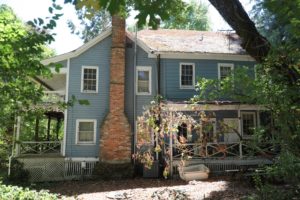










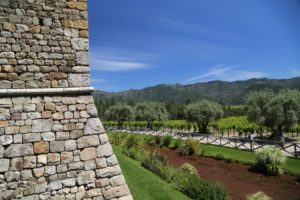










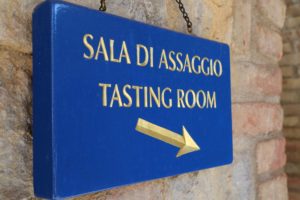



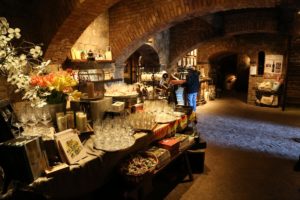
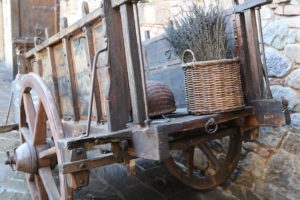
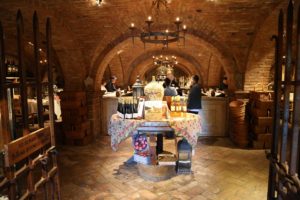









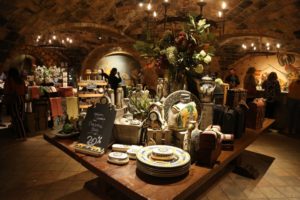




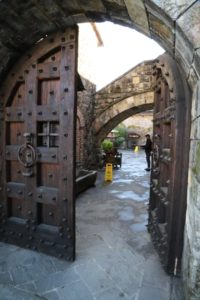



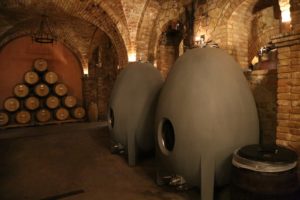



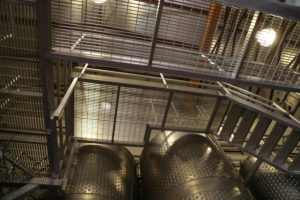

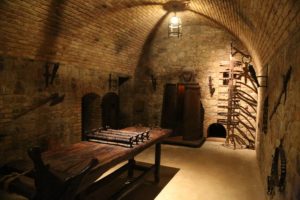

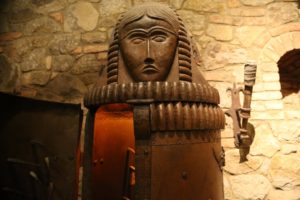

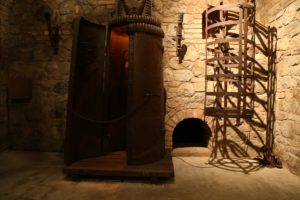


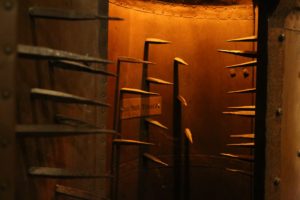
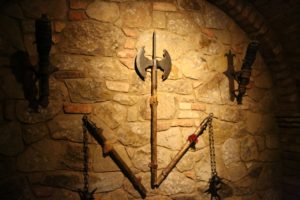







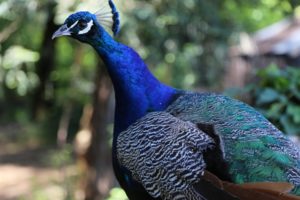












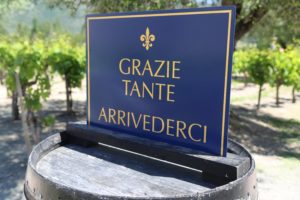






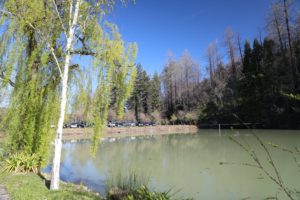











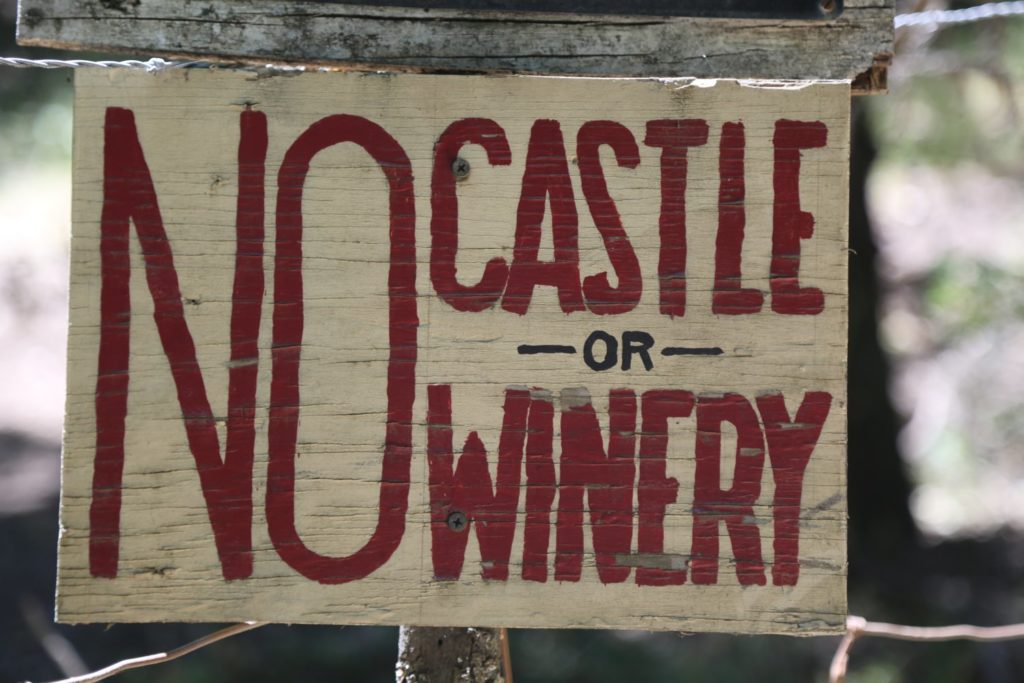
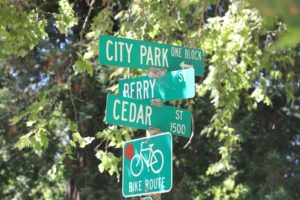
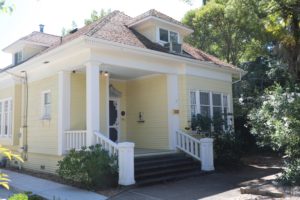




















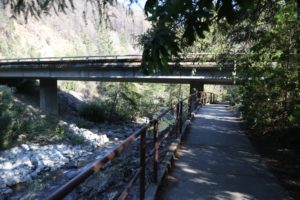







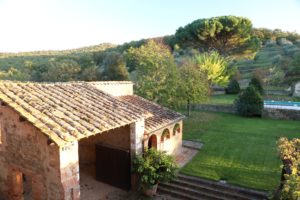
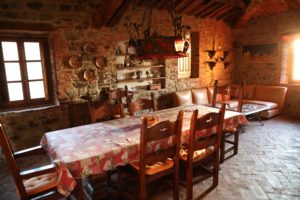















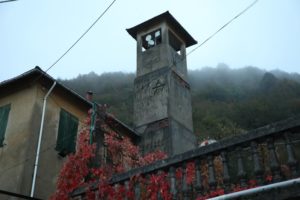



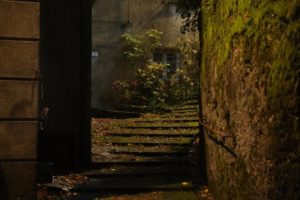






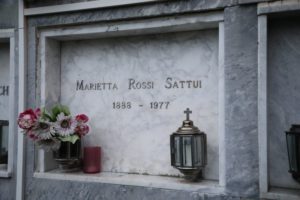

















Can’t believe the fire started burning inside the side stone building – what a mess :(((